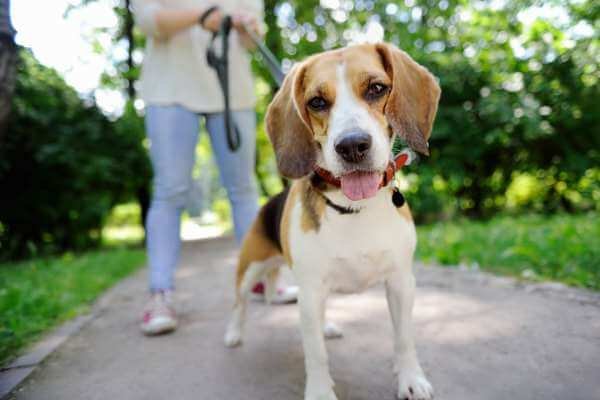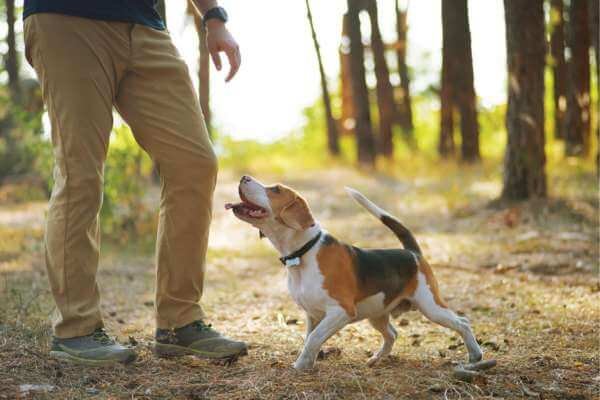Beagles are adorable, friendly, and energetic dogs that make great companions for people of all ages. They are also very curious and love to explore the world with their powerful noses. However, this can also pose a challenge when it comes to letting them off the lead. Beagles are scent hounds, which means they were bred to hunt and track prey by following their scent. This instinct can sometimes override their obedience and make them run off after an interesting smell, ignoring your calls and commands. So, can beagles be let off the lead safely and reliably? The answer is yes, but it requires a lot of patience, consistency, and positive reinforcement. In this article, we will share some tips and tricks for off-leash training your beagle and how to prevent them from wandering off.
Why Off-Leash Training Is Important for Beagles
Off-leash training is not only a matter of convenience but also of safety and enjoyment. By teaching your beagle to walk off the lead, you can:
- Give them more freedom and exercise, which can improve their physical and mental health.
- Strengthen your bond and trust with your beagle, which can enhance your relationship and communication.
- Reduce the risk of accidents and injuries, such as getting tangled in the leash, running into traffic, or getting into fights with other dogs.
- Have more fun and adventure with your beagle, as you can explore new places and activities together.
Off-leash training is also beneficial for situations where you might need to have more control over your beagle, such as when you visit the vet, groomer, or a friend’s house. By teaching your beagle to come when called, stay by your side, and leave it when asked, you can prevent them from getting into trouble or causing a nuisance.
How to Train Your Beagle to Walk Off the Lead

Training your beagle to walk off the lead is not impossible, but it does require a lot of time and effort. Beagles are smart and eager to please, but they can also be stubborn and easily distracted. Therefore, you need to make the training fun, rewarding, and consistent. Here are some steps to follow:
Start early
The best time to start off-leash training is when your beagle is still a puppy, as they are more impressionable and adaptable. However, you can also train an adult beagle, as long as you are patient and persistent.
Start indoors
Before you take your beagle outside, you need to teach them some basic commands, such as sit, stay, come, and leave it. You can use treats, toys, or praise as rewards for obeying your commands. Practice these commands indoors, where there are fewer distractions and more control.
Start with a long leash

Once your beagle has mastered the basic commands indoors, you can move on to the outdoors. However, don’t let them off the lead right away. Instead, use a long leash, such as a 20-foot or 30-foot leash, that gives your beagle enough room to roam and sniff, but also allows you to reel them in if needed. You can also use a harness instead of a collar, as it gives you more control and prevents choking or injury.
Start with a safe and enclosed area
The next step is to find a safe and enclosed area, such as a fenced yard, a dog park, or a field, where you can practice off-leash training. Make sure the area is free of hazards, such as traffic, wildlife, or other dogs, that might tempt or scare your beagle. Also, make sure the area is not too large or too crowded, as it might overwhelm or confuse your beagle.
Start with short and frequent sessions
Don’t expect your beagle to walk off the lead for hours on the first day. Instead, start with short and frequent sessions, such as 10 minutes or 15 minutes, and gradually increase the duration and distance as your beagle improves. Also, make sure to end each session on a positive note, by rewarding your beagle with a treat, a toy, or praise.
Start with low distractions
Don’t expose your beagle to too many distractions at once, such as other dogs, people, or noises, as they might trigger their hunting instinct and make them run off. Instead, start with low distractions, such as a quiet and familiar place, and gradually introduce more distractions as your beagle becomes more confident and obedient.
Start with the recall command
The most important command for off-leash training is the recall command, which means your beagle should come to you when you call their name. To teach this command, you can use a whistle, a clicker, or a word, such as “come” or “here”. To practice this command, you can:
- Call your beagle’s name and show them a treat or a toy. When they come to you, reward them with a treat or a toy and praise them. Repeat this several times until your beagle associates their name with a positive outcome.
- Call your beagle’s name and run away from them. When they chase you and catch up with you, reward them with a treat or a toy and praise them. Repeat this several times until your beagle associates their name with a fun game.
- Call your beagle’s name and hide behind a tree or a bush. When they find you, reward them with a treat or a toy and praise them. Repeat this several times until your beagle associates their name with a challenge.
- Call your beagle’s name and wait for them to come to you. When they do, reward them with a treat or a toy and praise them. Repeat this several times until your beagle responds to their name without any visual or auditory cues.
Start with the stay command
The next important command for off-leash training is the stay command, which means your beagle should stay in one place until you release them. To teach this command, you can:
- Ask your beagle to sit and show them a treat or a toy. Say “stay” and take a few steps back. If your beagle stays in place, reward them with the treat or the toy and praise them. If your beagle moves, say “no” and start over. Repeat this several times until your beagle stays in place for a few seconds.
- Ask your beagle to sit and show them a treat or a toy. Say “stay” and take a few steps back. Then, call your beagle’s name and say “come”. If your beagle comes to you, reward them with a treat or a toy and praise them. If your beagle moves before you call them, say “no” and start over. Repeat this several times until your beagle stays in place until you release them.
- Ask your beagle to sit and show them a treat or a toy. Say “stay” and take a few steps back. Then, drop the treat or the toy on the ground and say “Leave it”. If your beagle stays in place and ignores the treat or the toy, reward them with another treat or toy and praise them. If your beagle moves and tries to get the treat or the toy, say “no” and start over. Repeat this several times until your beagle stays in place and leaves the treat or the toy alone.
How to Prevent Your Beagle from Wandering Off
Even if you train your beagle to walk off the lead, there is always a chance that they might wander off or get lost. To prevent this from happening, you can:
- Always keep an eye on your beagle and never let them out of your sight. If you notice that they are getting too far away or too distracted, call them back and reward them for returning to you.
- Always have a backup plan in case your beagle does not respond to your commands. For example, you can have a whistle, a clicker, or a squeaky toy that can catch their attention and make them come back to you. You can also have a long leash or a retractable leash that you can use to reel them in if needed.
- Always have your beagle wear a collar and a tag with your name and phone number or a microchip with your contact information. This way, if your beagle does get lost, someone can easily identify them and return them to you.
- Always check the weather and the terrain before you let your beagle off the lead. Avoid letting your beagle off the lead in extreme weather conditions, such as heat, cold, rain, or snow, as they might affect their health and behavior. Also, avoid letting your beagle off the lead in unfamiliar or dangerous terrain, such as rocky, muddy, or steep areas, as they might injure themselves or get stuck.
- Always respect the rules and regulations of the places where you let your beagle off the lead. Some places, such as public parks, beaches, or trails, might have specific rules or restrictions regarding off-leash dogs, such as designated areas, time limits, or fees. Make sure to follow these rules and regulations to avoid any trouble or fines.
Conclusion of Can Beagles Be Let Off the Lead
Training beagles to walk off the lead requires patience, consistency, and positive reinforcement. This article offers tips for safely teaching your beagle to enjoy off-leash walks, emphasizing that each beagle is unique in training needs. Highlighting the continuous nature of off-leash training, it stresses the importance of monitoring behavior, providing positive reinforcement, and avoiding punishment. Off-leash privileges should be granted only when confidence in your beagle’s readiness and reliability is established. By following these guidelines, off-leash training can be a positive and enjoyable experience for both you and your beagle.

